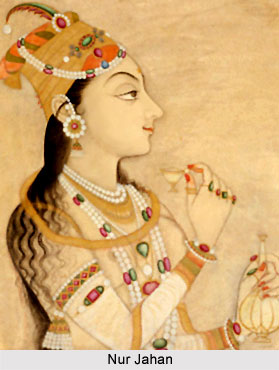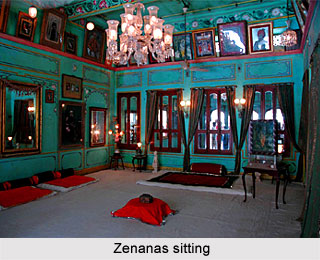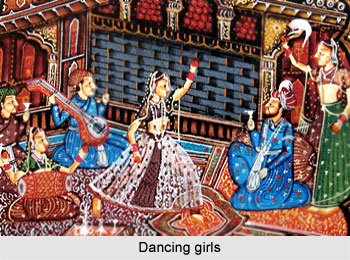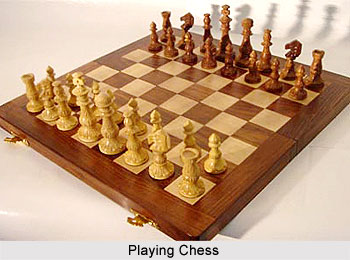 Mughal Zenanas were the places in the palaces reserved exclusively for the Royal women. The Zenana was the centre of perpetual competition in adornment, dress, and holding singing and dancing performances. Each princess had her own musicians and dancing girls, and they vied to outdo the artistes of the other princesses. In their respective harems, the ladies were allocated ceremonial robes, or Sarapas, and jewels, and they perennially admired and disparaged each other`s attire, fashion, beauty treatments, jewellery, and suchlike.
Mughal Zenanas were the places in the palaces reserved exclusively for the Royal women. The Zenana was the centre of perpetual competition in adornment, dress, and holding singing and dancing performances. Each princess had her own musicians and dancing girls, and they vied to outdo the artistes of the other princesses. In their respective harems, the ladies were allocated ceremonial robes, or Sarapas, and jewels, and they perennially admired and disparaged each other`s attire, fashion, beauty treatments, jewellery, and suchlike.
Organisation of the Zenanas
Each princess ruled over her section of the palace. Under her was a Mahaldar who supervised her servants and slaves with an iron hand and also spied for the emperor. The princess would patronize various noble ladies and wives of Omrahs. She would choose the names of her slaves, usually according to their function, appearance, or talents- `Gulah` (rose), `Gul Anar` (pomegranate flower), `Chambeli` (jasmine), `Hira` (diamond), `Moti` (pearl), or `Pista` (pistachio). Eunuchs watched zealously over the princess, helped by the guards of the zenana, who were strong and sturdy slave women from Kashmir or Uzbekistan, armed with bows and arrows.
Usually the emperor chose the eunuchs for this great responsibility himself, since he had to have confidence in them. They also acted as spies, and were supposed to ensure that nothing illegal occurred in the harem. Their chief, or Nazir, guarded the personal treasure of the princess and took care of her wardrobe and expenses. All the slaves had to blindly obey him. A scribe recorded all visitors to the Zenana and kept a check on all the activities. Anything of note he passed on to the vizier, who would immediately report to the emperor.
 Each Princess had her own private collection of gems and they rivaled each other in brilliance. Often they would wear pearls in great profusion, covering their wrists, chests, and ankles. Jewellers were constantly being commissioned by members of the royal household to produce gold ornaments and to mount pearls in the form of the moon, a crescent, or a star, as well as making special items of other gems. It has been noted by some historians that there has been mention of trays filled with rubies which had only been polished and roughly shaped in the form of fruit, then pierced and hung from a gold string. Each princess had several sets of precious stones, to match their various dresses. They changed four or five times a day, according to the ceremonies of the court. The costumes were sumptuous and scented with rose essence, which were previously imported from Persia till Nur Jahan developed the technique to manufacture it indigenously. Other scents were also popular, such as orange-flower, jasmine, and sandalwood, while cloaks were packed in caskets perfumed with camphor leaves to repel moths.
Each Princess had her own private collection of gems and they rivaled each other in brilliance. Often they would wear pearls in great profusion, covering their wrists, chests, and ankles. Jewellers were constantly being commissioned by members of the royal household to produce gold ornaments and to mount pearls in the form of the moon, a crescent, or a star, as well as making special items of other gems. It has been noted by some historians that there has been mention of trays filled with rubies which had only been polished and roughly shaped in the form of fruit, then pierced and hung from a gold string. Each princess had several sets of precious stones, to match their various dresses. They changed four or five times a day, according to the ceremonies of the court. The costumes were sumptuous and scented with rose essence, which were previously imported from Persia till Nur Jahan developed the technique to manufacture it indigenously. Other scents were also popular, such as orange-flower, jasmine, and sandalwood, while cloaks were packed in caskets perfumed with camphor leaves to repel moths.
Dressing up in the Zenana
The dresses of the ladies of the Zenana were of the latest fashion. For instance during Aurangzeb`s reign, the style was for garments to be wide and flowing, whether short or long-sleeved. One special innovation in ladies` fashion in this era was the Angiya, a fitted, short-sleeved bodice, which was worn over a long skirt and encircled by a belt of pearls or brocade with a buckle of precious stones, often with a bunch of pearl grapes hanging from it. The women of the court also wore trousers, over which was a knee-length tunic with a v-shaped bodice. The Papoush, or slippers, were embroidered with gold threads. The ladies wore their hair either untied and falling to the hips or braided with white pearls. A muslin veil, a sort of Dupatta but wider, f white or matching colour, was worn framing the face like a halo.
 For the royal ladies, dressing up was an elaborate and very long process. They would spend a great deal of time in front of their mirrors, and took great care of hygiene. Their toothpaste was a special mixture of a tree root and a paste made of burnt and crushed ground seashells, black pepper, coarse salt, and hookah residue. The eyes were outlined with antimony powder, and the lashes thickened with Mikhal or Kajal (made of soot from oil lamps).
For the royal ladies, dressing up was an elaborate and very long process. They would spend a great deal of time in front of their mirrors, and took great care of hygiene. Their toothpaste was a special mixture of a tree root and a paste made of burnt and crushed ground seashells, black pepper, coarse salt, and hookah residue. The eyes were outlined with antimony powder, and the lashes thickened with Mikhal or Kajal (made of soot from oil lamps).
Other cosmetics were betelnut juice for reddening the lips, musk pastilles to sweeten the breath, and sandalwood paste to improve the complexion. The hands and feet were dyed with henna, and this was a long and delicate operation. After the application, women covered their hands with a red lace. This lace must have served as gloves, which were uncomfortable to wear because of the heat. Servants aided the ladies, un-braiding their hair, then combing it for a great length of time, then oiling it with a mixture of incense, soot, and oil, afterwards braiding it once again, coiling it up, and pinning it back in place. In official ceremonies, princesses wore a brocade or silk turban surmounted by an egret feather held by a brooch of precious stones. The feather was a sign of honour conferred by the emperor.
Entertainment in the Zenana
Once finished dressing up, they would be ready to receive visitors, sitting resplendent on tortoiseshell seats embedded with strips of mother of pearl or ivory, or lying lazily on stately couches or beds. Their attendants would wave heart-shaped fans above them, made of a porcelain or mother-of-pearl handle, an ivory stem, and fluffy white feathers. They entertained their lady guests with rose, lemon, or orange juice sherbets sweetened with honey, scented with violets, and filled with raisins from Balkh. From the imperial kitchens, slaves supervised by eunuchs would bring milk or cream covered with gold leaf; yogurt mixed with honey, cashew nuts, and saffron; mango juice or almond milk with cardamoms, and, in summer the `nimbu pani` (lemon water). Slaves would wield flycatchers and fans, and the room would be kept fresh and cool by the scented velvet screens at the windows, on which water was continuously sprinkled.
 At these functions, the princesses would pool their dancing girls and musicians to entertain the visitors. These artistes were usually Hindus converted to Islam. Dancing was a highly cultured and refined art inherited from the Hindus. The dancers wore the traditional costumes of short, wide skirts over long, silk, shapeless leggings, and leather anklets lined with innumerable tiny bells that tinkled with their foot movements. By special dispensation of the emperor, the palace dancers were allowed to wear turbans with egret feathers. Torches on tripods lit the rooms and were reflected on silvered ceilings or the myriad tiny mirrors embedded in the walls. Another extravagant custom of the harem was serving Kichari, which was a bowl of stew in which pieces of gold, gems, and pearls were mixed with the vegetables. The Mahaldars who organized the parties received monetary rewards and ceremonial garments.
At these functions, the princesses would pool their dancing girls and musicians to entertain the visitors. These artistes were usually Hindus converted to Islam. Dancing was a highly cultured and refined art inherited from the Hindus. The dancers wore the traditional costumes of short, wide skirts over long, silk, shapeless leggings, and leather anklets lined with innumerable tiny bells that tinkled with their foot movements. By special dispensation of the emperor, the palace dancers were allowed to wear turbans with egret feathers. Torches on tripods lit the rooms and were reflected on silvered ceilings or the myriad tiny mirrors embedded in the walls. Another extravagant custom of the harem was serving Kichari, which was a bowl of stew in which pieces of gold, gems, and pearls were mixed with the vegetables. The Mahaldars who organized the parties received monetary rewards and ceremonial garments.
The ladies indulged in artistic pleasures like music, singing, organizing parties, and going on pilgrimages, which, along with military campaigns, were among the few outings they were allowed to have. They also passed time playing chess, Chauparas, and cards. Playing cards was called Ganfila. Chauparas game is the forerunner of Ludo and was very popular with the ladies. They played it on a velvet cloth shaped like a cross and used three dice similar to the ones used today. The velvet arms were called plansa, and the squares drawn on them were Khanas. There is a miniature in Lahore Museum showing four young girls absorbed in this game. The stake could be a jewel, a piece of calligraphy, a perfume vial, or coins.
Even though intoxicants were not allowed in the Zenana except as medication, yet the ladies managed to smuggle them in and often indulged in wine or opiates. Opium, or `Afeem`, dissolved in water and mixed with saffron to make it palatable, served as a good stimulant. Bhang was another popular intoxicant. This is a derivative of cannabis that is only found in the sub-continent. It has a calming effect. It was often taken mixed with Black Pepper, dissolved in water or Milk flavoured with Clove or cucumber juice. Another concoction of bhang was with milk mixed with Charra Maghaz, a combination of the dried seeds of watermelon, melon, and a kind of pumpkin, and ground almonds, added to khaskhash, ground Poppy Seed, a common enough condiment which has a mild soporific effect. Then there was Datura, which is a deadly poison, but if a minute quantity was mixed with poppy seeds, nux vomica, and sugar, the resulting elixir became an aphrodisiac. Hemp, or hashish, was also mixed in tobacco and smoked in a hubble-bubble; the water of the pipe aided in cooling the fumes which induced a sense of well-being.
Thus was life in the Mughal Zenanas. Undoubtedly the ladies must have felt suffocated with all the close supervision maintained by the Emperor and his guards and spies at the Zenana. However their life was one of utmost luxury and extravagance, free to do as they willed within the confines of the Zenana.



















